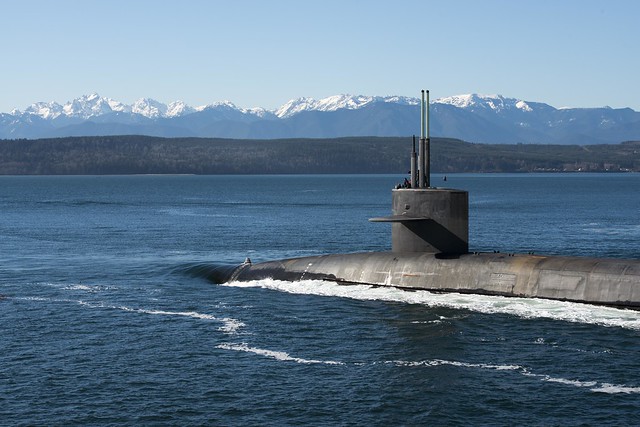 Photo Courtesy: Official U.S. Navy Page on Flickr
Photo Courtesy: Official U.S. Navy Page on Flickr
5 Reasons Why Low-Yield Nukes Are Not a Good Idea
“We have enough” concluded Admiral Mike Mullen when, earlier this week, he was asked about the size of the US nuclear arsenal.
Unfortunately, not everyone agrees. The 2018 Nuclear Posture Review, released last February, introduced the possibility of adding a new kind of nuclear weapon to the existing US nuclear arsenal. More specifically, there’s talk about producing the W76-2: a nuke with a 6.5 kiloton warhead, loaded either on a SLBM or an SLCM.,
The current administration is insisting on these new weapons in order to “match” low-yield weapons within the Russian nuclear stockpile. But this is unnecessary, as there are at least five reasons why these weapons should not be added to the US arsenal.
1. They would create a dangerous problem of misperception.
All the SLBMs in the American arsenal, namely the Trident II D5 missiles, are able to carry up to eight thermonuclear weapons (W76s and W88s). These submarine-launched missiles, however, could just as well be loaded with low-yield weapons. The low-yield weapons would, hypothetically, be used to respond to a Russian detonation of a similar low-yield weapon. Since no early warning systems are able to detect the explosive power of a particular warhead loaded on a missile, Russia wouldn’t be able to tell what kind of nuke the missile would be loaded with.
Unable to detect the yield of the warheads launched, Russia could overreact and retaliate with a massive salvo of high-yield nuclear weapons. The introduction of low-yield nukes would therefore create an ambiguity problem – one that could potentially trigger a nuclear war.
2. Nuclear modernization doesn’t depend on them.
Saying the US doesn’t need new nukes doesn’t imply the US shouldn’t keep its arsenal updated and capable of constituting a credible deterrent. Even those opposing the idea of low-yield nuclear weapons do, in fact, support nuclear modernization. Just last month, for instance, House Armed Services Committee Chairman Adam Smith stated that “it’s not […] debatable that we need to modernize our nuclear force.”
3. It’s a waste of money.
The Pentagon’s Fiscal Year 2020 Budget presents an estimate of the cost for the production of low-yield nuclear weapons. Overall, adding these weapons to the US arsenal would require approximately $17 billion. Even on their own, the modifications the Navy would have to make to its submarines would cost around $50 million. It’s more money for weapons that aren’t needed.
4. It’s a matter of principle.
In 1968, the US signed the NPT. The treaty is based on the idea of nuclear reduction. If the US were to produce new nuclear weapons, it would inevitably go against that goal. What’s more, it’s important not to tack US defense spending decisions entirely to Russia’s actions. If the US wants to maintain the independence of its defense budget, it shouldn’t allow useless Russian nuclear weapons to take valuable money from weapons systems the US actually needs.
5. We risk undermining the current balance of nuclear deterrence.
By claiming low-yield nukes would better allow the US to respond to various forms of aggression, the Nuclear Posture Review is basically implying that a strategy based on deterrence doesn’t work. The very idea of deterrence is based on the concept of discouraging an opponent from using a nuclear weapon. If the purpose of these new weapons is to convince that opponent that the use of a small nuclear detonation would only invite an in-kind response instead of a massive retaliation, then the US is tacitly acknowledging that it is willing to tolerate a small nuclear detonation.
Moreover, by stating the current US nuclear arsenal is not adequate for a potential US-Russia confrontation, the US risks creating pointless panic among its allies, as well as its public audience. If the US wants not only to maintain its military superiority and effective nuclear deterrent, but also make sure the rest of the world perceives it this way, it shouldn’t bring into question the validity of its nuclear arsenal.
At the end of the day, it’s all about what the US conceives as its priority. When balancing the aspiration to match Russia’s every nuclear capability against lowering the threshold of a nuclear war, though, there shouldn’t be any hesitation.
The intention to add new weapons to the US nuclear arsenal suggests the current administration’s willingness to compete in a new nuclear arms race and, at the same time, it’s making such a scenario more probable. The US already has an impressive triad of nuclear weapons. So the question is, why would it risk it all?





